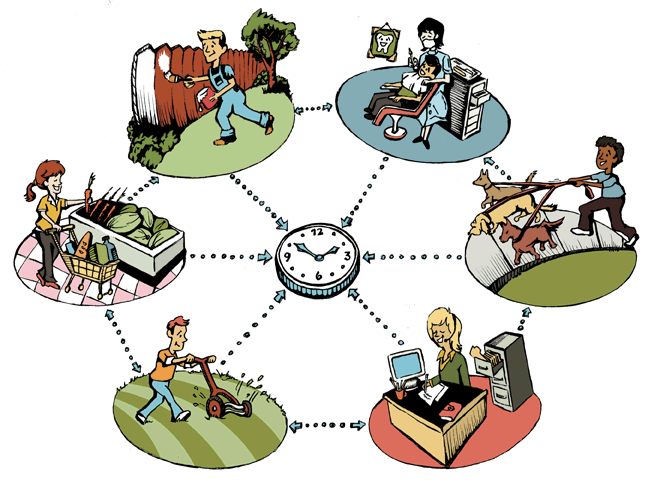These are, to put it gently, unsettling times. A triple whammy confronts us: climate change, peak oil, and a global economy in a possible death spiral. With things spinning so badly out of control, it’s easy to feel daunted.
A century ago, the poet William Butler Yeats described chaos’s onset this way: “The center cannot hold.” While his words still resonate, they don’t quite capture the current crisis, whose cause lies precisely in this: The global economy has no center. It’s a system in which capital sloshes from money center to tax haven, and corporations, in the words of writer David Ehrenfeld, are “everywhere and nowhere.” The result: From the Hudson Valley to Hong Kong, people are plugged into an economic matrix that has no face and is indifferent to yours. Talk about your primal helplessness! Here we are, attached to the same global teat, the milk is slowing to a trickle, and Mama’s on crank and doesn’t care.
Is it end-game time? Yes, if we’re referring to the era of plentiful, cheap oil. But don’t assume a high-tech Dark Ages is upon us. Out of the rubble of the old, a new, postglobal economic arrangement is emerging.
This is bracing in and of itself, and there’s more good news chugging along behind it. Though still very early-stage, this transformation is picking up momentum rapidly, and it has the potential to deliver deep renewal, not just marginal survival. Raise your hands if you prefer community to consumerism, empowerment to infantilization, autonomy to anonymity! I thought so.
The seeds of this next economy are sprouting in the Hudson Valley and a thousand other places, too. Though the particulars vary from region to region, the underlying principles are the same. Focus on local—local businesses, local agriculture, and local energy. Bring heart into the economy by strengthening the networks of connection among people. Do it on a grassroots level—people power!—and do it structurally, through institutions that keep the local system thriving and resilient.
Time = Money
One such institution is the Time Bank. The concept, which was invented by lawyer Edgar Cahn close to three decades ago, is as simple as it is innovative. People volunteer their time, but instead of just giving, they also receive. For every hour of service they provide, they get an hour back. Throw a couple hundred people with a wide variety of skills into the pot, and you can get anything you want at the Time Bank restaurant, maybe including Alice.
For Woodstock resident Kristine Flones, the Time Bank was love at first listen. She first heard about the concept in late 2006 at a Newburgh presentation by Edgar Cahn. “I had an instant connection with what I heard,” she says. “Time Banks offer a paradigm shift to a different, heart-based way of living. They can take us beyond our scarcity-based money system to a culture of abundance, sustainability and, dare I say it, happiness.”
Flones was so taken by the concept that she decided to launch a Time Bank in her hometown. The rest, as they say, is history. In the roughly two years since its founding, the Woodstock Time Bank has blossomed into a thriving and rapidly-growing community of over 200 members. “We’re one of the wunderkinds of the Time Bank world,” says Flones.
Woodstock resident Harriet Kazansky speaks glowingly of the Time Bank. She has tapped into it to have (deep breath, now!) the outside of her house stained, her new kitchen plumbed, electrical work performed, rooms painted, gardening done, furniture moved, fixtures hung, a skylight repaired, and an outside water spigot installed. “Pretty much anything you can imagine, I’ve used the Time Bank for,” says Kazansky.
Heidi Washburn is another booster. A year ago, a significant birthday was approaching for the Bearsville resident. Her daughter kept pushing her to throw a big party, but it felt like too much work. Then a light went off: the Time Bank! Volunteers prepared the house—no small matter, by Washburn’s account—and cooked for and photographed the event. A nonevent became a grand success.
In addition to networking volunteers, Time Banks build community. The Woodstock Time Bank hosts regular social events, and what’s more, participating in an informal “gift economy” has its own special magic. Reports Washburn, “Volunteers helped out with my birthday party with a wonderful, generous spirit you rarely get when you’re simply hiring people.”
Time Banks are also a great resource for nonprofits. This is because charitable organizations often rely on volunteers—more so than ever during these cash-strapped times—and it’s much easier to recruit people when they know they’ll get something back, even if it’s not a paycheck. Family of Woodstock is one of several nonprofits that are partnering with the Woodstock Time Bank. “It’s been a very positive experience,” says Family’s Jess Robie.
In their own quiet way, Time Banks are powerfully subversive. Culturally we are steeped in hierarchy. Brain surgeons earn more than plumbers who earn more than house cleaners. We tend to view this as a law of nature, but it’s not. It’s a social custom that’s gotten embedded in our heads, and it can be dislodged where there’s a will and a way. Time Banks value hours equally, whether you’re snaking a drain or saving a brain. They’re the Great Flattener. In fact, they’re almost, dare I say it, socialist!
But what about the IRS, you ask? Aren’t these transactions taxable? The surprising answer is: no. Because volunteers aren’t guaranteed a quid for their quo, timebanking transactions are no more taxable than your usual one-way volunteering.
Technically, timebanking is what is known as a “complementary currency.” This is because, like the currency we all know called the dollar, it’s a medium of exchange. But it isn’t only hours that can stand in for Treasury issue. Local forms of money can, too. This is perfectly legal, and it’s been happening for a long time. In Wörgl, Austria, in 1932, the city issued scrip that had a sort of financial entropy built into it: it became less valuable over time. Because people didn’t want to pay what amounted to a hoarding fee, the scrip circulated rapidly. The result, during the height of the Great Depression, was a surge in employment and the completion of local government projects such as new houses, a reservoir, a ski jump, and a bridge.
Fair Shares
Complementary financial currencies like the Wörgl scrip generate local economic resiliency because they decouple the communities they serve from the global economy: They release them, so to speak, from the global teat. If a currency isn’t accepted in Bentonville, Arkansas—which just happens to be where Wal-Mart is headquartered—the company will shun it.
About 2,500 local currencies are currently in use worldwide. A compelling nearby example can be found in Great Barrington, Massachusetts, where people can swap dollars for BerkShares at five local banks. For every 95 US dollars, they get 100 BerkShares, giving them a built-in financial incentive to go local. Since their launch in mid-2006, $2.4 million in BerkShares have circulated through the community. Some 375 businesses, from acupuncturists to wineries, accept the currency.
At this point, BerkShares are used by 10–15 percent of the greater Great Barrington population. Higher participation would be better. “We underestimated the extent to which a full-fledged educational campaign would be necessary,” says Sarah Hearn, the office manager for the Great Barrington-based
E. F. Schumacher Society, the organization behind the endeavor.
The long-term goal is for BerkShares to take root through the Berkshire mountain area that inspired their name. “The greater Great Barrington area has a population of 19,000. Our total target area has 139,000 residents,” Hearn says. “We already have 20 businesses in Pittsfield and are looking for more.”
The Schumacher Society’s ambitions extend beyond the region. According to Hearn, the organization hopes to “expand the currency nationwide, as a model to be replicated by communities everywhere.”
When that happens—and we’re into long-term visioning now—additional programs will be tacked onto the initiative. One example: the currency, says Hearn, “will be issued as productive loans to new or expanding import-replacing industries.”
Getting BerkShares launched has had its challenges. Start-up costs have been considerable, creating an ongoing need to drum up foundation support. To a significant degree, reports Hearn, this is because the Schumacher Society “is conducting research and development into best practices and procedures, so other communities can take these steps more easily and affordably.”
The number of BerkShares in circulation has tailed off lately due to the economic downturn. Hearn remains optimistic, though. “Interest has been spiking in the concept.”
Indeed it has, and in Time Banks, too. Local currency initiatives are underway in Rhinebeck, where the currency is called Rhinebucks, and in Kingston, where Uptown resident Sean Griffin is putting together plans for a Hudson Valley-wide currency called the Hudson Valley Current. (Clever names seem to be de rigeur). Time Banks are in development in the Red Hook/Rhinebeck area and Great Barrington.
Why this flurry of activity? For one thing, it’s part of the natural flow of things. These concepts have been around for a while; it takes time for them to travel from the margin to the mainstream. This evolutionary process is being aided and abetted by the current economic implosion, which is transforming perceptions—what once seemed radical now seems practical and necessary—and lighting a fire under creative economic alternatives.
So pause for a moment, if you will, and imagine what it would be like to live in a Hudson Valley with its own robust and resilient economy. It would still be connected to the world beyond—the global village isn’t going away—but we’d all be leaning on one another more (cue the Rolling Stones) instead of scrabbling to get to the shriveling global teat. Lots of us would be using a local currency and giving (and getting) at the Time Bank.
Banking On It
The resilient local economy of the future would receive additional bolstering from institutions that haven’t made it to the Hudson Valley yet. Imagine a financial institution that takes the locally owned bank concept one step further by providing innovative services like free local credit-card processing for local businesses and microloans for new businesses and community projects—and that also dedicates all profits to schools and other nonprofits. If you find this hard to do, then wait a bit. If Kingston resident Sean Griffin has his way, a Common Good Bank designed along precisely these lines will be available to local residents before the year’s end.
Of course, there’s still the wee challenge of getting from where we are now to the vibrant local economy of our imagination. How to do it? First: Keep the faith. This promised transformation is getting more real by the day. Second: Make it happen. If we’re going to be weaned from the global teat, the only people who can do it are…that’s right, us. Nothing comes for free. Empowerment and autonomy bear a price: responsibility.
Is this a burden? A little, maybe. But it’s also an opportunity, and an upbeat one at that. Creating a resilient local economy isn’t a dour, solitary, Sisyphean exercise. It’s about working alongside our friends and neighbors to create a better future. It’s about connecting more, and better.
Sounds like fun to me.
For more information
Woodstock Time Bank www.timebanks.org
BerkShares www.berkshares.org
Common Good Bank www.commongoodbank.com












